Please allow me to introduce myself... Mick Jagger
View my new website Click Here
Hello, my name is Melinda Piesse and I am a textile artist from the Mornington Peninsula, Victoria, where I live by the sea with my husband Wayne Parr, a traditional shipwright by trade.
I studied Fine Art at Monash University and completed a Bachelor of Visual Arts, majoring in tapestry, with Kate Derum as my mentor. I achieved first class Honours the following year and completed a teaching degree and a Master of Fine Arts in 2011.
I am currently completing a large scale tapestry inspired by the historic shipwreck of the Batavia off Western Australia in 1629. I call the work a tapestry because it is a narrative based artwork, in the tradition of European tapestry, that tells a story, although technically speaking it’s a large scale wool embroidery on linen fabric.
The Batavia Tapestry (Detail)
First I’d like to begin by showing you some images of artwork completed at Monash University.
Tapestry is a fantastic medium to work with, unlike needlepoint, you construct the fabric, weaving with wool on a warp of strong cotton twine, wound continuously around a loom and knotted off. It takes time to set up a warp correctly- it needs to be firm and even in tension for weaving.
The first picture above shows a tapestry created in my final undergrad year. You can see the cartoon behind the weaving with a black outline marked on the warp using Indian ink.
This is a detail of the main figure Galatea, a sea nymph from classical mythology. The inspiration came from a famous Raphael painting of the same name, depicting a battle at sea. Art History is major inspiration for me, particularly Renaissance artists like Raphael. I was particularly drawn to the central female figures and decided to appropriate them, in my own design.
The following pictures show installations of ropework and tapestry at Monash, created for my Honours Year in 2006. At the time I was beginning to explore alternative mediums and experimenting with different techniques, which led me towards maritime art.
This is an installation space I made, in my studio, during my Honours year at Monash. I painted the walls and tented the ceiling and presented two painted and embroidered textile pieces featuring elements of old world maps and a compass rose in dimensional goldwork
The next picture represents a show at Craft Victoria, which I was awarded for my Honours Year’s work. It shows a range of different textile mediums, including a hand painted silk flag, rough hewn boat sculptures with woven sails and other sailor arts.
There you see some details of artwork from the show, which was heavily influenced by sailor arts, with embroidered ditty bags, ropework and ships with tapestry sails.
That summer, I began to study the history of trade, discovery and exploration and I began dreaming up the idea of embroidering a full scale sail in the style of early charts.
I find the images of early maps, to contain a bit of magic, a sense of wonder and discovery when early explorers set out into the unknown without contemporary tools we take for granted today, like satellite navigation.
In the 17th Century, Australia’s coastline was a bit of a mystery, there were rough ideas of the whereabouts of the great southland, charted on secret maps that were more precious than gold.
I became fascinated with this area of early discovery and shipwrecks that pepper our coast line and finally found a story that localised all of the areas of my interest—with the shipwreck of the Batavia in the treacherous Abrolhos Islands off WA in 1629.
The research I did for my Master of Fine Arts, was really extensive and kind of like time-travelling in which I set out to learn as much as I could about 17th Century Europe- including trade routes, artists and crafts of that era, including traditional sail-making, ropework and lace-making.
Vermeer’s Lacemaker shows a young girl at work on her lace, which is created using threads, pinned to a hard lace pillow. I became fascinated with the craft of lace-making, and learnt how to make traditional Bobbin lace, in order to be able to recreate a piece of 17th Century lace as an art project.
I started as a complete novice with a kit bought through the Australian Lace Guild, with the aim of learning bobbin lace in order to be able to have the skills necessary to recreate historic lace.
I learnt how to make lace to trim a pair of shoes and how to bead and embellish lace for my wedding dress- which was all practice really, towards recreating a famous piece of lace discovered amongst the wreckage of 17th Century shipwreck, salvaged in the 1970s off Western Australia.
The original lace was made of linen and has a famous history and is a romantic symbol of survival, having survived nearly 400 years beneath the waves off Western Australia. It’s the earliest European textile associated with Australia and came off a very famous ship, called the Batavia which was like the Titanic of its day, in the 17th Century. The image above represents my reconstruction of the Batavia lace, in Japanese gold.
The Batavia was an important ship, belonging to the Dutch East India Trading Company which was a huge corporation of the 17th Century. Really they held the purse strings of the world having access to Asia and the spice islands of the Pacific. They sent countless ships out of Europe to trade and collect riches from around the world.
I have always been interested in costume and created these pockets embroidered with emblems of the VOC. Ladies pockets were not part of women’s clothing historically before the 19th Century and were worn separately over the petticoats attached to a belt.
There’s a detail showing the goldwork embroidery on flax sailcloth. I use authentic materials in my work and source materials and tools all over the world…


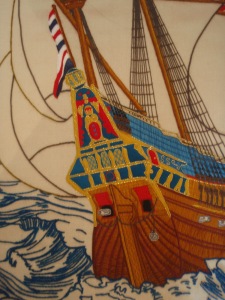
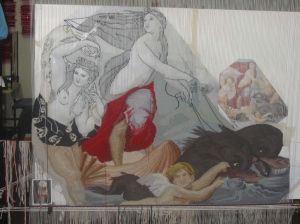


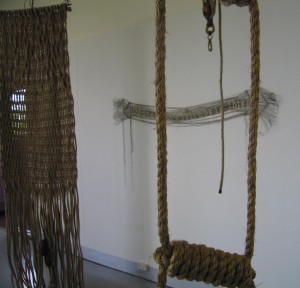
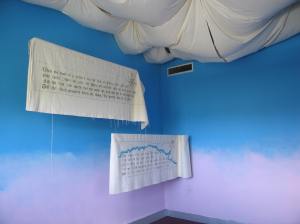

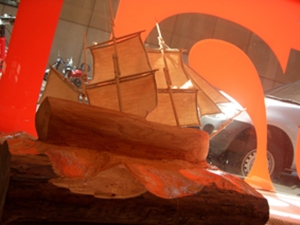




It is absolutely beautiful and so much looking forward to seeing the real tapestry in Hobart next February!
LikeLiked by 1 person
Thankyou!
LikeLike